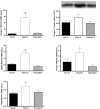Akt signalling through GSK-3beta, mTOR and Foxo1 is involved in human skeletal muscle hypertrophy and atrophy
- PMID: 16916907
- PMCID: PMC1890416
- DOI: 10.1113/jphysiol.2006.116715
Akt signalling through GSK-3beta, mTOR and Foxo1 is involved in human skeletal muscle hypertrophy and atrophy
Abstract
Skeletal muscle size is tightly regulated by the synergy between anabolic and catabolic signalling pathways which, in humans, have not been well characterized. Akt has been suggested to play a pivotal role in the regulation of skeletal muscle hypertrophy and atrophy in rodents and cells. Here we measured the amount of phospho-Akt and several of its downstream anabolic targets (glycogen synthase kinase-3beta (GSK-3beta), mTOR, p70(s6k) and 4E-BP1) and catabolic targets (Foxo1, Foxo3, atrogin-1 and MuRF1). All measurements were performed in human quadriceps muscle biopsies taken after 8 weeks of both hypertrophy-stimulating resistance training and atrophy-stimulating de-training. Following resistance training a muscle hypertrophy ( approximately 10%) and an increase in phospho-Akt, phospho-GSK-3beta and phospho-mTOR protein content were observed. This was paralleled by a decrease in Foxo1 nuclear protein content. Following the de-training period a muscle atrophy (5%), relative to the post-training muscle size, a decrease in phospho-Akt and GSK-3beta and an increase in Foxo1 were observed. Atrogin-1 and MuRF1 increased after the hypertrophy and decreased after the atrophy phases. We demonstrate, for the first time in human skeletal muscle, that the regulation of Akt and its downstream signalling pathways GSK-3beta, mTOR and Foxo1 are associated with both the skeletal muscle hypertrophy and atrophy processes.
Figures





References
-
- Anderson T, Kearney JT. Effects of three resistance training programs on muscular strength and absolute and relative endurance. Res Q Exerc Sport. 1982;53:1–7. - PubMed
-
- Atherton PJ, Babraj J, Smith K, Singh J, Rennie MJ, Wackerhage H. Selective activation of AMPK-PGC-1α or PKB-TSC2-mTOR signaling can explain specific adaptive responses to endurance or resistance training-like electrical muscle stimulation. FASEB J. 2005;19:786–788. - PubMed
-
- Baldi JC, Jackson RD, Moraille R, Mysiw WJ. Muscle atrophy is prevented in patients with acute spinal cord injury using functional electrical stimulation. Spinal Cord. 1998;36:463–469. - PubMed
-
- Bodine SC, Latres E, Baumhueter S, Lai VK, Nunez L, Clarke BA, Poueymirou WT, Panaro FJ, Na E, Dharmarajan K, Pan ZQ, Valenzuela DM, DeChiara TM, Stitt TN, Yancopoulos GD, Glass DJ. Identification of ubiquitin ligases required for skeletal muscle atrophy. Science. 2001a;294:1704–1708. - PubMed
-
- Bodine SC, Stitt TN, Gonzalez M, Kline WO, Stover GL, Bauerlein R, Zlotchenko E, Scrimgeour A, Lawrence JC, Glass DJ, Yancopoulos GD. Akt/mTOR pathway is a crucial regulator of skeletal muscle hypertrophy and can prevent muscle atrophy in vivo. Nat Cell Biol. 2001b;3:1014–1019. - PubMed
Publication types
MeSH terms
Substances
LinkOut - more resources
Full Text Sources
Other Literature Sources
Research Materials
Miscellaneous

